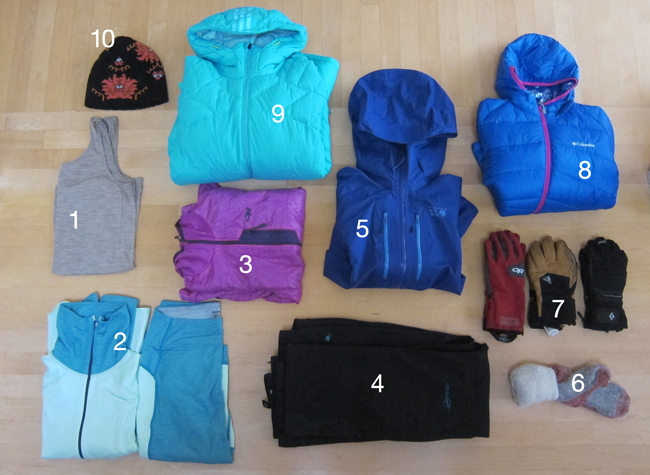
The key to staying warm when ice climbing is to dress in layers. You need to be able to start out the day wearing just your baselayer or midlayer for the approach, then continue to add and remove layers throughout the day as you climb and belay. This is my current ice climbing apparel setup for the season. While the individual pieces may change from year to year, the general layering concept remains the same.
1. Icebreaker Siren Tank ($55): I always wear a merino wool tank as my first next to skin layer (apart from a sports bra of course). Even if I should start to sweat, the wool will help keep my core warm. If for some reason I get really sweaty on an approach, I can always just take it off.
2. Patagonia Cap 4 ($79-$99): Warm base layers are a must and you can’t get much better than the tried and true expedition weight Cap 4. Treated with Polygiene, these wicking base layers stop the growth of odor-causing bacteria on the fabric, so you can wear them more than once before washing.
3. Outdoor Research Deviator Hoody ($185): While technically a Spring ’15 piece, this jacket serves as a great midlayer for ice climbing. Polartec Alpha in the front and sides keeps your core warm, while Power Dry High Efficiency in the arms and back wicks away moisture while crucially not adding any bulk. Bonus: The Deviator Hoody can serve as your spring climbing outer layer.
4. Millet Monterosa Pant ($135): These slim fitting, softshell pants are lined with fleece for extra warmth. Cuff guards protect the fabric from the inevitable errant crampon, while preformed knees mean you can kick and “get scrunchy”, as Conrad Anker likes to say, to your heart’s content. Inner gaiters help to keep snow out of your boots on deep approaches.
5. Mountain Hardwear Alchemy Jacket ($395): This softshell climbing jacket is made from Mountain Hardwear’s Dry.Q Elite technology so is highly breathable while remaining water- and windproof. I prefer chest pockets on my climbing jackets, as they remain well out-of-the-way of your harness or pack hipbelt and are easy to access quickly in the thick of it. Another key feature for me on a climbing jacket is the large internal mesh pocket for storing your extra pair of gloves–nothing worse than unknowingly dropping them halfway up a route. The helmet-compatible hood is adjustable and most importantly, lets you look up when deployed. The active fit means no extra bulk.
6. SmartWool Mountaineer Socks ($24): These have been my favorite climbing socks for years.
7. Gloves: You need at least three sets of gloves–one for the hike in, one for belaying, and one for climbing. The OR StormTracker Gloves ($70) are made from Gore Windstopper to keep your hands warm but not sweaty on the hike in and prep phase. The First Ascent Guide Gloves ($130) are my go-to belay gloves with PrimaLoft insulation, a merino wool liner, and durable Pittards leather palm to protect against rope burn when lowering and rappelling. The Black Diamond Punisher ($100) are the classic climbers–they keep your hands warm but also give you the dexterity you need to confidently lead tough pitches. Black Diamond finally made a women’s version this year. Tip: store your belay gloves inside your jacket as you climb to keep them warm and vice versa when belaying.
8. Columbia 890 TurboDown Hooded Jacket: The serves as my multi-pitch belay jacket as it stuff downs small in my pack and since it is made from a combination of down and synthetic insulation, it will keep me warm even if I am stuck halfway up a climb in worsening conditions.
9. Adidas Terrex ClimaHeat Ice ($350): The perfect cragging belay jacket for places such as Hyalite Canyon or the Ouray Ice Park. Stuffed with PrimaLoft Down Insulation (a synthetic-down mix), this cozy warm jacket uses a two-way zipper to give you unencumbered access to the front of your harness in order to safely belay.
10. Sherpa Adventure Gear Hat ($20-$25): I always wear a nice warm hat under my helmet–preferably one that drops low enough to cover your ears. Removing your hat on the approach is a great way to cool yourself down if you start to overheat. All the Sherpa Adventure Gear hats are hand knit in Nepal and help support the local community.

